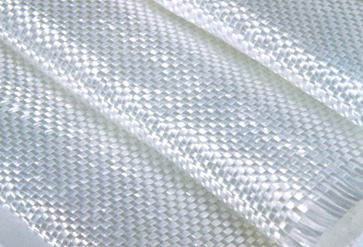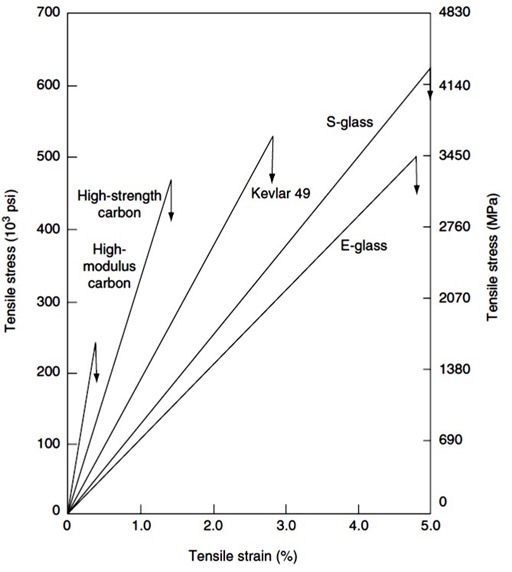 In this introductory post, common reinforcements for composites will be presented. This will serve to “set the table” for future discussions on prepregs, laminates and a wide range of fiber reinforced composites. The choice of reinforcement is a critical factor when designing or selecting composite materials since in many applications, the properties of the composite are dominated by the reinforcement. Reinforcements are typically non-isotropic (i.e. they have directionality) which results in properties that may be different in the X, Y, and Z directions. For example, a unidirectional fiber composite may have very high strength in the fiber direction owing to the majority of the load being carrier by the fiber and poor strength in the transverse direction due to the load being carried by the resin matrix. Composites are designed so that a large portion of the load is carried by the reinforcements resulting in high strength to weight ratios. The chemical nature of the reinforcement as well as the form of the reinforcement are important composite design parameters. In the next two sections, the types of reinforcements and the reinforcement forms will be discussed.
In this introductory post, common reinforcements for composites will be presented. This will serve to “set the table” for future discussions on prepregs, laminates and a wide range of fiber reinforced composites. The choice of reinforcement is a critical factor when designing or selecting composite materials since in many applications, the properties of the composite are dominated by the reinforcement. Reinforcements are typically non-isotropic (i.e. they have directionality) which results in properties that may be different in the X, Y, and Z directions. For example, a unidirectional fiber composite may have very high strength in the fiber direction owing to the majority of the load being carrier by the fiber and poor strength in the transverse direction due to the load being carried by the resin matrix. Composites are designed so that a large portion of the load is carried by the reinforcements resulting in high strength to weight ratios. The chemical nature of the reinforcement as well as the form of the reinforcement are important composite design parameters. In the next two sections, the types of reinforcements and the reinforcement forms will be discussed.
Types of reinforcements
- Glass fibers
- Carbon or graphite Aramid (Kevlar) fibers
- Ultra High Molecular Weight Polyetheylene (UHMWPE) fibers
- Exotic fibers (boron)
- Particulate fillers (ceramic fillers (calcium carbonate, fumed silica), metal fillers)
In Figure 1, the stress strain curve is shown for some typical fibers used in composites.
Figure 1. Tensile stress versus tensile strain for a variety of reinforcement materials typically used in composites (1)
The most common type of composite reinforcement is E-glass. From the stress-strain data, E-glass has the lowest modulus, but has relatively good tensile strength. E-glass is also the most inexpensive glass fiber. E-glass is commonly available in many forms (see below). S-glass offers a higher modulus and tensile strength but comes with a cost premium compared to E-glass. Moving to the left in Figure 1, one sees that Kevlar 49 has both a higher modulus and tensile strength compared the the glass fibers. Carbon fibers have the highest moduli and the high strength carbon fibers have about the same tensile strength as E-glass with a significantly higher modulus. Note that for the high modulus carbon fiber, the tensile strength decreases, so this fiber would be used where the modulus and stiffness would be the more important design criteria. Table 2.1 in reference 1 provides a nice overview of the material properties (tensile modulus, tensile strength, strain-to-failure, CTE, and Poisson’s ratio) for a wide variety of commercial reinforcing fibers.
Common reinforcement forms:
- Continuous tows (unidirectional)
- Woven fabrics and braided sleeves (bidirectional)
- Non-continuous chopped fibers (discrete fibers and fiber mats)
- Particulate fillers
The following figure shows a schematic of the various reinforcement forms and how they are used in a multilayer layup stack in the final composite.
Figure 2. Basic building blocks of fiber-reinforced composites (1)
Once the type of fiber is chosen (e.g. glass, carbon, Kevlar) then depending on the application, the form is selected. Unidirectional fibers offer the potential to have high load bearing in use, but typically need to be applied in layers in the stack-up to achieve the desired properties. As can be seen in the laminate in the lower left in Figure 2, multiple unidirectional plies are stacked at 0o, 90o and 45o (0, 90, 45,45,45,45,45,90,0) in a symmetric layup. An advantage of woven fabrics is that the weave geometry can be tailored to give the required properties in the X and Y directions. Woven fabrics have different weave types (plain/square, twill, satin) and can have various yarn counts in the X (warp) and Y (weft/fill) directions. For example, satin weave glass fabrics have good drapeability (for forming over complex curved shapes) and low crimp. Crimp is the angle between the crossing fibers and lower crimp yields improved mechanical properties since straighter fibers can carry higher loads.
Composites made using bulk molding compounds (BMC) and sheet molding compounds (SMC) are made using chopped glass fibers. BMC’s typically contain randomly oriented short chopped E-glass fibers. SMC materials are also made using randomly oriented chopped E-glass fibers. As shown in the lower right layup in Figure 2, a combination of outer plies with unidirectional fibers can be combined with inner layers containing unidirectional discontinuous (chopped) fibers to provide the requisite mechanical properties at the target cost.
In the next several posts we will dive deeper into matrix resins used in typical composites
References:
1) Fiber-reinforced Composites, Materials, Manufacturing, and Design, P. K. Mallick, CRC Press, 2007



Leave a Reply